RUPESTRE (L.) P.V.Heath, 1984
Synonyms :
Sedum rupestre L. (1753) in part, in the sense of 't Hart & Jarvis (1994)
Sedum reflexum L. (1755) / Petrosedum reflexum (L.) Grulich (1984) / Sedum rupestre var. reflexum (L.) Hegi & Em.Schmid (1922) / Petrosedum rupestre ssp. reflexum (L.) Velayos (1989)
Sedum glaucum Donn (1804) nom. illeg. / Sedum reflexum ssp. glaucum (Donn) Janchen (1962)
Sedum collinum Willd. (1809) / Sedum reflexum fa collinum (Willd.) Rouy & Camus (1901)
Sedum cristatum Schrader (1809)
Sedum recurvatum Willd. (1809) / Sedum reflexum fa recurvatum (Willd.) Rouy & Camus (1901)
Sedum virescens Willd. (1809)
Sedum albescens Haw. (1821) / Sedum rupestre ssp. albescens (Haw.) P. Fournier (1936) / Sedum reflexum ssp. albescens (Haw.) Rouy & E.G.Camus ex Jovet & R.Vilmorin (1974)
Sedum crassicaule Link (1821)
Sedum fragile Dumort. (1827)
Sedum reflexum var. viride W.D.J.Koch (1837)
Sedum reflexum var. glaucum W.D.J.Koch (1843) / Sedum rupestre var. glaucum (W.D.J.Koch) Marches. (1897)
Sedum graniticum Pérard (1869)
Sedum reflexum fa adpressum Rouy & E.G.Camus (1901)
Sedum reflexum fa cristatum Praeger (1921)
Type : BM [lecto : Herb. Clifford, p. 177, Sedum 4]
Etymology : ‘rupestris’ Lat. ‘rock-’ : for the often rocky habitat of the plants.
Distribution : S Fennoscandia (Sweden, Finland) to S Europe (incl. Sicily and the Pyrenees) and N Balkans.
Description (by 't Hart & Bleij in IHSP, 2003) :
Glabrous perennials.
Non-flowering branches procumbent, rooting, basally, often somewhat woody.
Leaves imbricate, linear to oblong, mucronate, terete, with a truncate spur, 10 - 15 mm, green or glaucous.
Flowering branches ascending, 15 - 35 cm.
Inflorescences terminal corymbs with 4 - 7 monochasial branches, (sub-) globose in bud, branches drooping in bud, bracts leaf-like,
Flowers (5- to) 7- (to 9-) merous, (sub-)sessile, sepals basally connate, triangular-ovate, acute-acuminate, 3 - 4 mm, glabrous or sparsely glandular-pubescent, petals oblong, yellow, 6 - 7 mm, spreading during anthesis, filaments papillose, rarely smooth, yellow, anthers yellow, nectar scales transversely oblong, fruits erect, brown, seeds oblong, brown, costate.
Cytology : 2n = 88, 112, 120
P. rupestre is an allopolyploid. It evolved through polyploidization from a natural (sterile) hybrid of tetraploid P. forsterianum (2n = 48) and tetraploid P. erectum (2n = 64) some time after the last glaciation. The new species (2n = 112) arose somewhere in the western Mediterranean region and being fully fertile, it spread successfully over the whole of western Europe ('t Hart & al. 1993a).
Ray Stephenson (Sedum, Cultivated Stonecrops, 1994, pp 122 - 123) :
Common name : Crooked stonecrop
Petrosedum rupestre is a sturdy, fairly upright plant with 30-cm (12-in) tall inflorescences of bright yellow and 6- or 7-partite flowers, which are reflexed in bud. Leaves are stiff, succulent, apiculate, and terete. Plants do not die back to tight clusters of soft leaves at stem tips in summer, though some forms appear to be reduced to leaf clusters on the ends of fairly erect, stiff, sturdy, bare stems.
Habitat : The crooked stonecrop is native to Central and Western Europe : Belgium, Holland, Denmark, Norway, Sweden, France, Germany, Luxemburg, Iberia, Italy, Switzerland, Czech Republic, Slovakia, and Poland; and has been introduced elsewhere in a multitude of settings from coastal sand dunes to about 2000 m (7000 ft) in the Pyrenees Mountains. It was probably introduced from Flanders in the Middle Ages to Ireland and England as a salad crop.
Main points of distinction : Vegetatively, Petrosedum rupestre is very similar to P. sediforme, but the latter usually has flatter-topped, wider leaves. It is also similar to P. ochroleucum and P. montanum, both of which are usually more creeping. Petrosedum rupestre has stiff leaves and reflexed inflorescences. Some glandular hair can be expected on inflorescences carrying, usually, 6- or 7-partite flowers with yellow, spreading petals.
Variation : This species is very variable and as a result has fooled experts over the centuries, causing much controversy. Nonetheless, it is distinct in all its forms, though plants need to be observed over a period of time for them to be identified with certainty. Propagations sold as Sedum albescens in England are in fact P. forsterianum (fa purpureum). A particularly glabrous, green, upright, robust form known as Sedum virescens Willd. is no more than a regional variation of Petrosedum rupestre. A particularly beautiful cristate form is often offered in the trade as Sedum rupestre fa cristatum or more usually S. reflexum fa cristatum.
't Hart (1978) reported that the basic chromosome number for Petrosedum rupestre is probably x = 16. Plants with 2n = 88, 112, and 120 have been discovered. Hébert (1983) records 2n = 56 for a Spanish plant and several other anomalies from more northerly areas.
Two variegated forms are commonly grown in the United States but are rarely seen elsewhere: 'Sandy's Silver Crest', a form that turns purple in strong sunlight and has particularly striking new growth of contrasting yellow-white, and 'Sea Gold', a truly variegated slow-growing cultivar.
Horticulture : Although Petrosedum rupestre is quite rampant, it is not unruly. It is a good species for the border, large rock garden, or indeed, any difficult spot in the garden. As ground cover, it is much more open and upright, and not as rapidly spreading as P. forsterianum. It grows well on a wall and often seeds itself around. The cristate form reverts very easily, so all normal shoots must be removed quickly. Only the cristate form requires some protection from rain in areas with particularly wet winters. Petrosedum rupestre should be hardy in most cold-temperate zones.
Observations à Bassurels (Lozère - France) alt. 700m, le 12 juin 2011. Sol acide schisteux / acid shist ground.
Petrosedum rupestre en boutons / in bud :
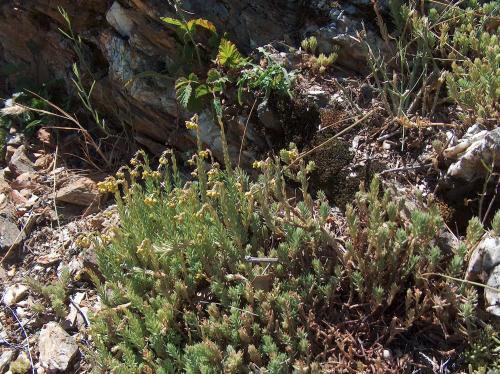
Petrosedum rupestre en fleurs / in flower :
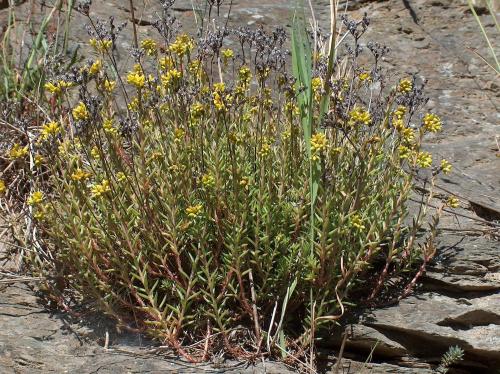
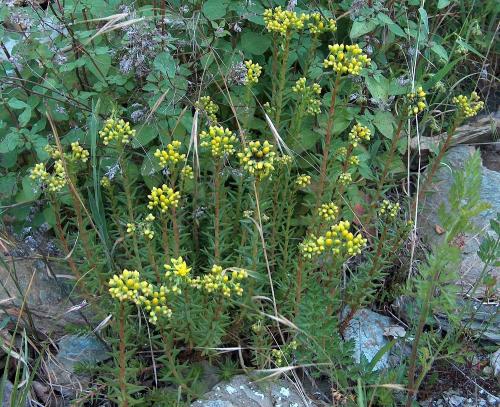
Petrosedum rupestre en fin de floraison / at the end of the flowering period :
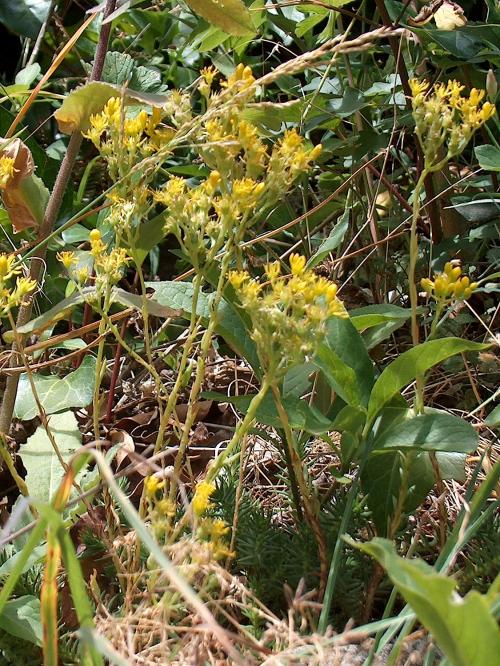
Plante cristée observée dans la zone du col Salidès (commune de Bassurels - 48), en bord de route. 27 mai 2012, alt. 950 m :
Crested plant in the region of Col Salidès (Bassurels), 950 m, off the road (27. May 2012) :
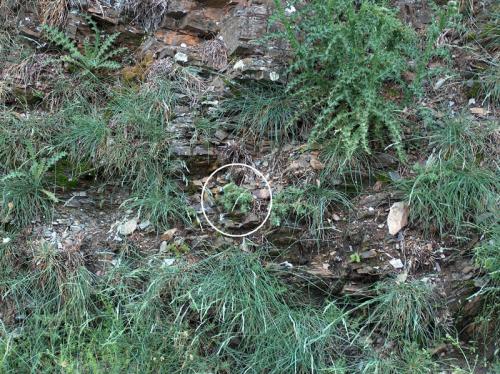
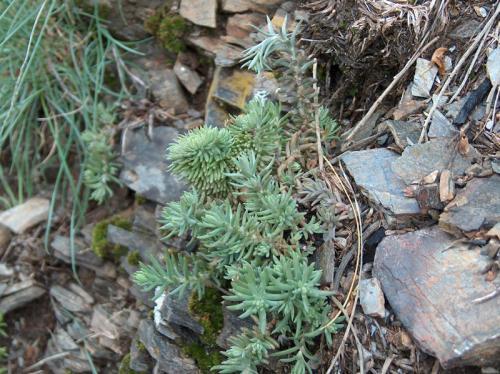
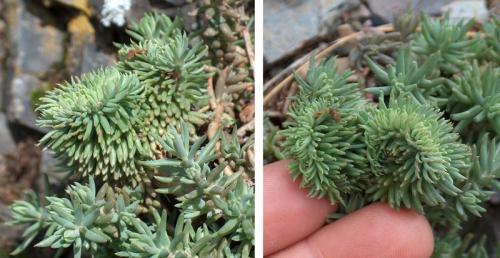
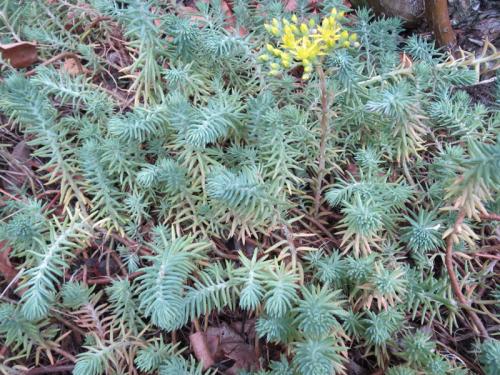
Photo Noelene Tomlinson
To see more photos : Crassulaceae in the Cévennes mountains by Eric Barbier
Sedum poussant en carrière d'ardoise de Trélazé, Anjou, France / Sedum in the schist quarry at Trélazé, Anjou, France by David Sorin